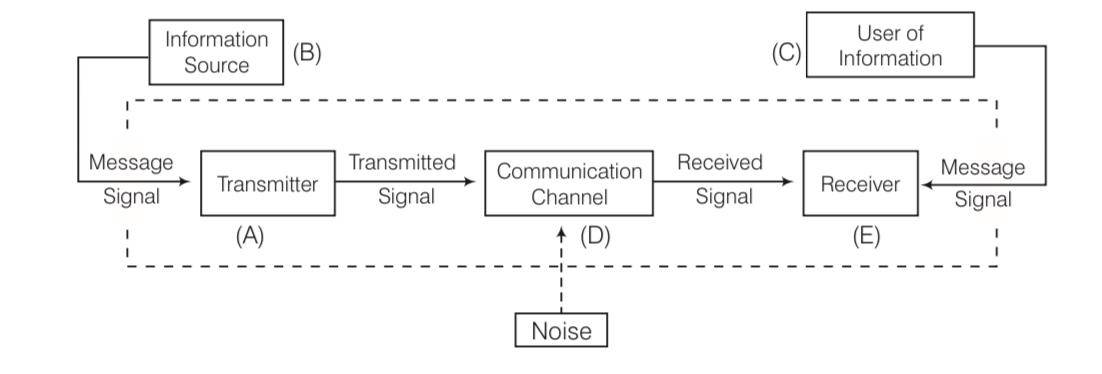Communication Systems
Get insights from 65 questions on Communication Systems, answered by students, alumni, and experts. You may also ask and answer any question you like about Communication Systems
Follow Ask QuestionQuestions
Discussions
Active Users
Followers
New answer posted
5 months agoContributor-Level 10
This is a Multiple Choice Questions as classified in NCERT Exemplar
Answer- a, b, d
Explanation- frequency is given by Vm=15KHz
So wavelength is given by
Also we know that l = = 5km
The audio signals are of low frequency waves. Thus, they cannot be transmitted through sky
Waves as they are absorbed by atmosphere.
If the size of the antenna is less than 5 km, the effective power transmission would be very
Low because of deviation from resonance wavelength of wave and antenna length.
New answer posted
5 months agoContributor-Level 10
This is a Multiple Choice Questions as classified in NCERT Exemplar
Explanation-equation of modulating wave is, m (t)= Amsinwmt
Carrier wave equation is Cm (t)= (Ac+Amsinwmt)sinwct
= Ac [1+ ]sinwct
Also = M
Cmt= (Ac+Ac )sinwct
Ac =K
Sinwmt= Vm
equation having phase
so equation is Ac+K2Vmt}+sinwct+ ]
New answer posted
5 months agoContributor-Level 10
This is a Multiple Choice Questions as classified in NCERT Exemplar
Answer- b
Explanation- it is represented by a diagram given below

New answer posted
5 months agoContributor-Level 10
This is a Multiple Choice Questions as classified in NCERT Exemplar
Answer- b
Explanation- Here, in this question, the frequency of modulated signal received becomes more, which is possible with the poor bandwidth selection of amplifiers.
This happens because bandwidth in amplitude modulation is equal to twice the
Frequency of modulating signal. But, the frequency of male voice is less than that of a female.
New answer posted
5 months agoContributor-Level 10
This is a Multiple Choice Questions as classified in NCERT Exemplar
Answer- c
Explanation- The device which follows square law is used for modulation purpose. Characteristics shown by (i) and (iii) corresponds to linear devices.
Characteristics shown by (ii) corresponds to square law device. Some part of (i) also
Follow square law.
Hence, (ii)and (iv) can be used for modulation.
New answer posted
5 months agoContributor-Level 10
This is a Multiple Choice Questions as classified in NCERT Exemplar
Answer- b
Explanation- frequency of career wave and frequency of amplitude modulated wave is same which is wc .
New answer posted
5 months agoContributor-Level 10
This is a Multiple Choice Questions as classified in NCERT Exemplar
Answer- a
Frequency of career signal = 1MHz and frequency = 3KHz= 0.003MHz
So frequency of side bands = 1 0.003
So 1.003MHz and 0.997MHz
New answer posted
5 months agoContributor-Level 10
This is a Multiple Choice Questions as classified in NCERT Exemplar
Answer-b
p = 1kW= 1000W
Attenuation of signal = -2dB/km and total path length = 5km
Gain in dB= 5
Gain in dB= 10 log (p0/pi)……. (i)
-10=10 log (p0/pi)= -10log (pi/po)
logPi/po=1 = log (pi/po)= log10
pi/p0=10= 1000W= 10p0
p0=100W
New answer posted
5 months agoContributor-Level 10
This is a Multiple Choice Questions as classified in NCERT Exemplar
Answer- a
length of building is given by l= 500m
And 4l= 4 100 =400mf
New answer posted
5 months agoContributor-Level 10
This is a Multiple Choice Questions as classified in NCERT Exemplar
Answer- b
Ground wave propagation – 530KHz to 1710KHz
Sky wave propagation- 1710KHz- 40MHz
Space wave propagation- 54MHz to 42GHz
Taking an Exam? Selecting a College?
Get authentic answers from experts, students and alumni that you won't find anywhere else
Sign Up on ShikshaOn Shiksha, get access to
- 65k Colleges
- 1.2k Exams
- 679k Reviews
- 1800k Answers

